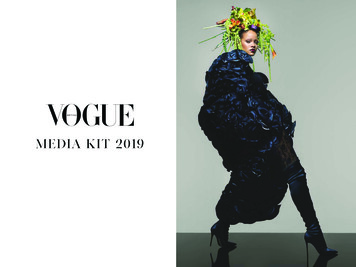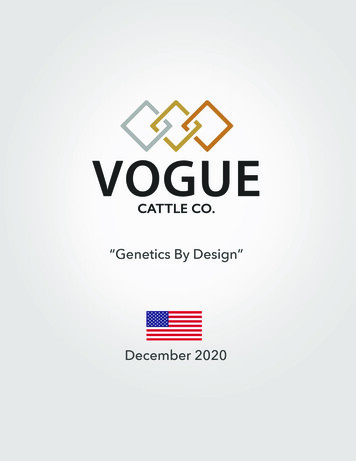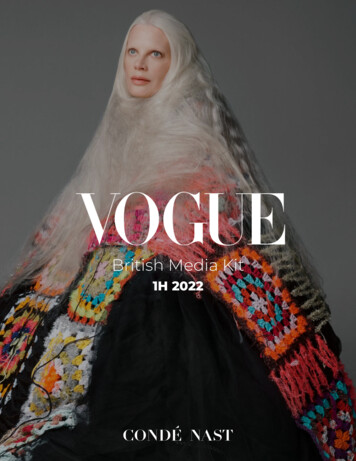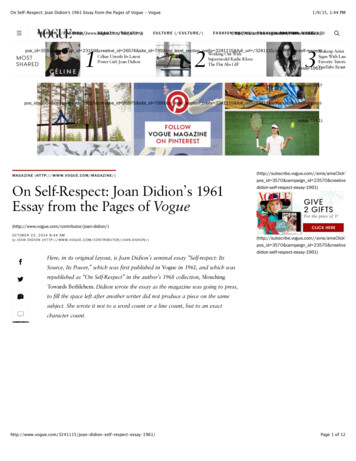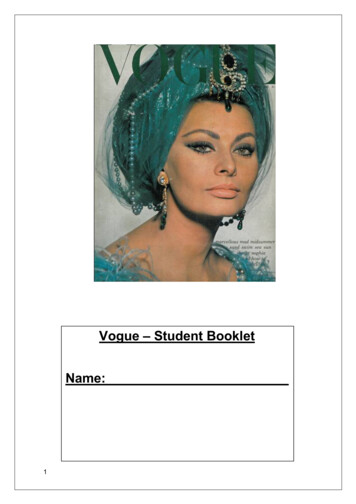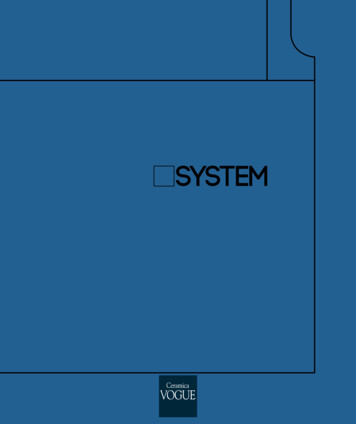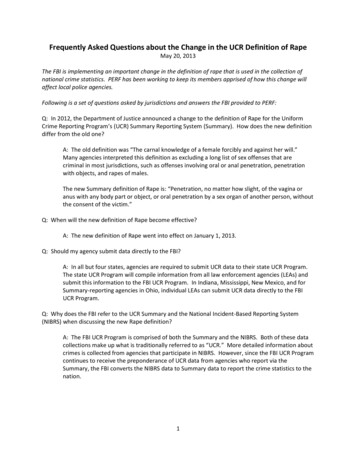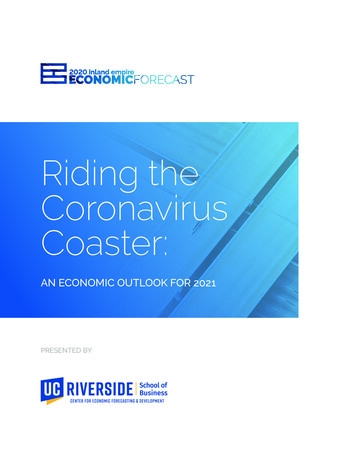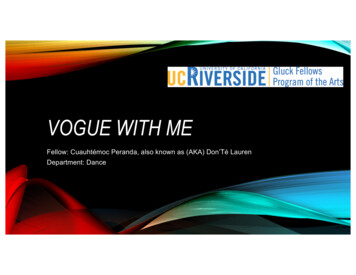
Transcription
1VOGUE WITH MEFellow: Cuauhtémoc Peranda, also known as (AKA) Don’Té LaurenDepartment: Dance
2WHAT IS VOGUE? Vogue (also known as Performance) is a dance formbased in the Black and Latinx, Queer and TransgenderHouse Ballroom Scene. Voguing is based in posing, runway walking, anddramatic or theatric movements. Voguing has three main styles: Old Way Vogue defined by hard lines, stoic poses, andconfident presentations. New Way Vogue like, old way, but with quick movements, andextreme stretches. Vogue Femme a softer or crazier feminized version of thedance.Image: Icon Dashaun Wesley xLanvin: -aria
HISTORY3 While the House Ballroom Scene was started by the Pioneer Crystal LaBeija,as rejection of Drag Balls in the late 1960’s that favored white Drag Queensinstead of Queens of color, voguing had a different start. Voguing was started as a dance called ”Poses, Poses, & More Poses” byPioneer Paris Dupree in 1969 at the first House Balls. Voguers had to reenact model poses from fashion magazines, to the musicof disco remix, in a beautiful flow of improvised choreography. Today, ‘vogue femme’ is the more popular form of voguing, which wascreated by transgender women (Femme Queens) after 1991. These womeninfuse their dancing with extreme feminine sensuality, in order to define, andconcretize their style in the House Ballroom Scene.Images: Crystal LaBeija, from Frank Simon’s The Queen, 1968. Paris Durpee, from Jenny Livingston’s Paris is Burning, 1991.
4HOUSES:CREATING FAMILIES Houses are chosen families, first created for LGBTQ children or young adults who were rejected by theirbiological families. Houses are collectives of people with similar interests, oftenattached to the House Ballroom Scene, or urban LGBTQ arts. Houses are not necessarily bound to a specificlocation, home or building. Houses are led by a “Father” or “Mother” with “children”to follow and grow. For example, the Legendary House of Lauren, International,is based in Chicago, with chapters of the House inCalifornia, Australia, Florida, Brazil, Texas, Italy, Nevada,New York, Florida, and Atlanta Photo Credit: Wingz Lauren, House of Lauren, Intl.
5 While Madonna is often the first name peoplethink of when referring to Vogue, she did notinvent it.MADONNA’S VOGUE Instead, she took the dance form, to the worldentertainment stage, from the underground DragBalls, House Ballroom Scene, and nightlifeclubbing of New York City, It is important to note, that the voguing inMadonna’s 1990 Vogue Music video waschoreographed by Legendary Icons Jose andLuis Xtravaganza, of the Royal House ofXtravaganza. The two choreographers remain active membersof the House Ballroom Scene today.Image Source: donnas-vogue-isthe-anthem-we-need-today/
6VOGUE INPOPCULTUREPop stars such as Fergie, Lady Gaga, Beyoncé, ArianaGrande, and Megan Thee Stallion continue to usevoguing and voguers to create, build, direct, dance in,and choreograph their performances.Unfortunately, many voguers and other artists of theHouse Ballroom Scene are not credited for their artwork,creativity or culture that contribute to popular culture.So, while major cultural influences come from the HouseBallroom Scene, the voguers themselves tend to stayunderground and secret, in their own community, tosafeguard their efforts.
BALLS TODAY Today, Balls take place all over the world—primarily incosmopolitan areas. While anyone can walk (compete/participate in) a Ball,their location and details are mostly shared throughword of mouth, with some level of secrecy. And,walking requires training The best way to see and understand a Ball is to watchthe now televised version Ball culture via HBO Max’sLEGENDARY.7
8While the dance form of voguing varies from location tolocation, from House to House, from country to country,from runway to theatre, there are certain movements,also know as elements, that remain the same, which are:ELEMENTS OFVOGUEHands PerformanceCatwalkDuckwalkDipsFloor PerformanceSpins
9HANDS PERFORMANCE Taken from various forms of Asian dance,pantomime, and Africanist andindigenous storytelling, HandPerformance focuses on the movementand dramatic imagery of the hands, inrelation to each other and the body. The goal is to have the hands and armsmove to the music playing, while the restof the body remains relatively still. Raving hand movement forms such as“the figure 8,” urban tutting, and ”bonebreaking” are all forms of HandsImage: The Legendary Javier Ninja, ja-street-jazz-818/Performance.
10CATWALK A catwalk is similar towalking down the runway, asfashion models do, but it ismuch more stylized. One must move forwardwith arms moving often incounterpoint to the legs.Credit: Icon Amazon Leiomy, New York Fashion Week, Disney’s Villains by The Blonds.
11DUCKWALK The duckwalk is like the catwalk, in that thevoguer locomotively moves forward, exceptthe voguer must be in a tight squatposition, rather than in a standing orwalking position. While there are many versions of theduckwalk, this element is characterized bythe dramatic movements of the hands withthe high energy of hips and legs, as ameans to taunt or demonstrate a dancer’sstrength.Leondrae Frank (center) vogues with others during a voguing practice at UnitedBlack Ellument in Dallas on Aug. 10, 2018. (Rose Baca/The Dallas MorningNews): und-you-likely-know-nothing-about/
12 Dips, can also be called inversion, and are any move that leads to a final pose in which one’shead is low to the ground, and other parts of the body are lifted vertically. The most common dip leads to a position where the voguer is on their back with one leg tuckedback, and the other is raised vertically.DIPSImage Source: https://www.balletx.org/classes/vogue-femme/
13FLOORPERFORMANCE Floor performance is anything onedoes on the ground. Often, this element is filled withposes on the ground, rolling,kneeling, and large fan kicks. Moving through different positionson the ground is very important tovoguing—just as much as standingposes and positions are.Image Source: egendary-vogue-dancer-leiomy-maldonado
SPINS14 Spins are turning one’s body around 360degrees. In voguing, voguers will spin multiple timesas a way to escape or lead into anotherelements. Spins may not always stay in one place orkeep one position, but morph and evolveas the voguer turns around.Image Source: in-voguefeature
OVAHNESS:LOVE YOURSELF15 The most important aspect of voguing is fabulosity, self-fashioning, or self-creation. You must love who you are in order to vogue. Voguers put all of themselves in their movement, to express their feelings, stories, andpersonalities—voguing is pretty much a kinetic self-portrait. From the fashion they wear, make-up, and the movements they make, voguers are showing you,expressing to you, telling you who they are, and that they love themselves. Ovahness, is a complete feeling, presentation, and performances of oneself to a personalperfection in love. Ovahness is necessary for good voguing.
16VOGUE WITH ME! Now that you have a basic understanding of voguing, it’s time for you to vogue withme and follow the dance video tutorials to experience voguing in your body. But, before you do that, please find a piece of paper, and write down:1. Why you love yourself 2. What you value in your life. What you are grateful for 3. What energy you or feeling you feel today, and what energy you want toexpress though your dancing and voguing
17THANK YOU And, here are some resources for further exploration of voguing and the HouseBallroom Scene: House Ballroom Scene History with Icon Niambi Prodigyhttp://www.LearnYourHistory.net/ Vogue Tutorials with the Star Gravity atured Vogue Classes with REACH LAhttp://www.reachla.org/
Vogue (also known as Performance) is a dance form based in the Black and Latinx, Queer and Transgender House Ballroom Scene. Voguing is based in posing, runway walking, and dramatic or theatric movements. Voguing has three main styles: Old Way Vogue defined by hard lines,

